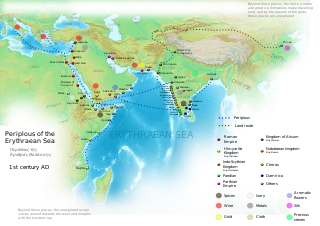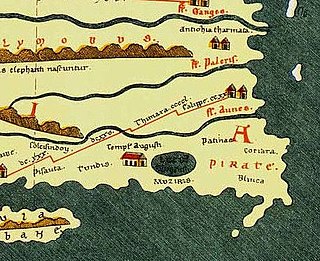
The Periplus of the Erythraean Sea, also known by its Latin name as the Periplus Maris Erythraei, is a Greco-Roman periplus written in Koine Greek that describes navigation and trading opportunities from Roman Egyptian ports like Berenice Troglodytica along the coast of the Red Sea, and others along Horn of Africa, the Persian Gulf, Arabian Sea and the Indian Ocean, including the modern-day Sindh region of Pakistan and southwestern regions of India. The text has been ascribed to different dates between the first and third centuries, but a mid-first-century date is now the most commonly accepted. While the author is unknown, it is clearly a first-hand description by someone familiar with the area and is nearly unique in providing accurate insights into what the ancient Hellenic world knew about the lands around the Indian Ocean.

Dragon's blood is a bright red resin which is obtained from different species of a number of distinct plant genera: Calamus spp. also including Calamus rotang, Croton, Dracaena and Pterocarpus. The red resin has been in continuous use since ancient times as varnish, medicine, incense, and dye.

Azania is a name that has been applied to various parts of southeastern tropical Africa. In the Roman period and perhaps earlier, the toponym referred to a portion of the Southeast Africa coast extending from northern Kenya to the border between Mozambique and South Africa. Azania was mostly inhabited by Southern Cushitic peoples, whose groups would rule the area until the great Bantu Migration.
Aromata, also called the Spice Port, was an emporium and seaport in the Horn of Africa, today a part of Somalia. It lay near the tip of Cape Guardafui, which was itself called the "promontory of spices". It was notable for its produce of resins and various herbs.
Rhapta was an emporion said to be on the coast of Southeast Africa, first described in the 1st century CE. Its location has not been firmly identified, although there are a number of plausible candidate sites. The ancient Periplus of the Erythraean Sea described Rhapta as "the last emporion of Azania", two days' travel south of the Menouthias islands. The Periplus also states that the city and port were ruled by South Arabian vassals of the Himyarite kingdom, particularly a certain “ Mapharitic chieftain.”

Cinnamomum tamala, Indian bay leaf, also known as tejpat, tejapatta,Malabar leaf, Indian bark, Indian cassia, or malabathrum, is a tree in the family Lauraceae that is native to India, Bangladesh, Nepal, Bhutan, and China. It can grow up to 20 m (66 ft) tall. Its leaves have a clove-like aroma with a hint of peppery taste; they are used for culinary and medicinal purposes. It is thought to have been one of the major sources of the medicinal plant leaves known in classic and medieval times as malabathrum.

Myos Hormos was a Red Sea port constructed by the Ptolemies around the 3rd century BC. Following excavations carried out recently by David Peacock and Lucy Blue of the University of Southampton, it is thought to have been located on the present-day site of Quseir al-Quadim, eight kilometres north of the modern town of El Qoseir in Egypt.
The Kirāta is a generic term in Sanskrit literature for people who had territory in the mountains, particularly in the Himalayas and Northeast India and who are believed to have been Sino-Tibetan in origin. The meaning of 'Kirata' referred by scholars as people with the lion's character, or mountain dwellers.
The Zanj Empire was a 19th-century political formation established by the Omani sultanate on the Swahili Coast. Known for its slave-trading activities in conjunction with the local Swahili people, at its peak, the polity's reach stretched as far as Eastern Congo. Eventually, the "Empire" collapsed when the British, intent on ending the slave trade, overtook it and incorporated it into the British Empire in 1896.
Berenice Epideires, or "Berenice upon the Neck of Land", was a town on the western shore of the Red Sea. It was located near the Bab-el-Mandeb strait, in modern-day Djibouti. The settlement's position on a sandy spit or promontory was the cause of its distinctive appellation. Some authorities, however, attribute the name to the neighborhood of a more considerable town named Cape Deirê on the Ras Siyyan peninsula. Strabon mentions the mangroves that were found there on the coast.
Ocelis or Okelis was a port on the Red Sea, on the Arabian side near or at Bab al-Mandeb, the strait separating the Red Sea from the Gulf of Aden, part of the ancient reckoning of Arabia Felix. It is placed by Ptolemy a little to the north of the straits of the Red Sea. It belonged to the Elisari, and was subject to Cholebus. The place also sometimes appears as Acila or Akila (Ἀκίλα).

The first documented relations between ancient Ancient India and Ancient Rome occurred during the reign of Caesar Augustus, the first Roman Emperor.

Alula, also spelled Aluula, is a coastal town in the northeastern Bari region and is part of the autonomous state of Puntland, on the coast of the Guardafui Channel. In the late 19th and early 20th centuries, it served as the main capital of the Majeerteen Sultanate. It is ten miles east of Ras Filuk and 100 nautical miles from Bender Cassim.

Tyndis was an ancient Indian seaport/harbor-town mentioned in the Graeco-Roman writings. According to the Periplus of the Erythraean Sea, Tyndis was located north of port Muziris in the country of the Cerobothra.

Barbaria was the name used by the ancient Greeks for littoral northeast Africa. The corresponding Arabic term, bilad al-Barbar, was used in the Middle Ages. The name of Barbaria is preserved today in the name of the Somali city of Berbera, the city known to the Greeks as Malao.
Ter is a village in Osmanabad district of Maharashtra state, India. It is 17 kilometres (11 mi) from the district headquarters, Osmanabad, 50 kilometres (31 mi) from Latur.
Ra's Sajir, also transliterated as Ra's Sājir, is a 900 m (3,000 ft) high sea cliff and headland in Dhofar, Oman. The cliffs are located near the town of Shaat and overlook the open Arabian Sea. This region of the Arabian Peninsula experiences a summer monsoon known as the Khareef. This leads to Ra's Sajir's green landscape in the summer months, unusual for much the Arabian region. Throughout history, Ra's Sajir has acted as a notable landmark for seafaring traders passing between the Red Sea and the Persian Gulf and India.

Cinnamomum malabatrum, wild cinnamon, country cinnamon also known as malabathrum, is a tree in the family Lauraceae that is endemic to Western Ghats of India. It can grow up to 15 malabathrum. It is locally known as Edana, Therali or Vazhana in Kerala.
Limyrikê is a historical region of present-day India, mentioned in the ancient Greco-Roman texts. It generally corresponds to the present-day Malabar Coast of Kerala.

Avalites was a small port in what is today Somalia that dominated trade in the Red Sea and Mediterranean.









